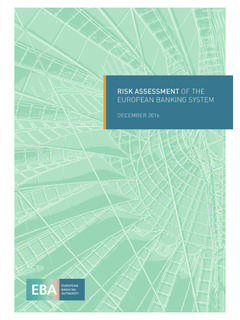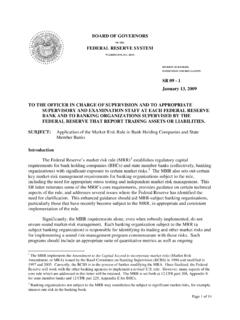Transcription of The Origins and Evolution of the Soviet Banking …
1 This PDF is a selection from an out-of-print volume from the National Bureau of Economic Research Volume Title: Money, Financial Flows, and Credit in the Soviet Union Volume Author/Editor: George Garvy Volume Publisher: NBER. Volume ISBN: 0-884-10475-3. Volume URL: Publication Date: 1977. Chapter Title: The Origins and Evolution of the Soviet Banking system : An Historical Perspective Chapter Author: George Garvy Chapter URL: Chapter pages in book: (p. 13 - 35). 1. bank officials mainly in the 2. improve under experimenta- ame time, it has The Origins and Evolution of the opposing the the bureau- Soviet Banking system : An ralized, adminis- Historical Perspective credit depends nting attempt to iniary incentives anned economy, in the years to of overall goals rket. THE Banking system that emerged after the October Revolution and, more specifically, after the credit reforms of 1930 1932 is unique in many respects.
2 To be sure, examples of Banking institu- tions combining central Banking and commercial Banking may be found in some nonsocialist countries. In the less developed coun- tries, central banks have frequently assumed a leading role in implementing development programs by providing the necessary financial institutions, instruments, and markets. Even in some leading industrial countries such as France and Italy large com- mercial banks are owned by the government. The uniqueness of the Soviet Banking system lies, rather, in the complete integration of monetary processes within the system of central planning, and in the credit and foreign exchange monopoly of the State Bank, which has broad powers of control over the perfor- mance of the entire state-owned segment of the economy. In historical perspective, the position of the State Bank of the (Gosbank) today may be viewed as the ultimate expres- sion of a relationship between government and Banking that has its roots in Tsarist Russia.
3 Making active use of official guidance, support, and stimulation to push the backward country toward modernization, the Tsarist government was one of the first any- where to press Banking into the service of economic progress. A. 13. 14 Origins and Evolution of Soviet Banking system State and B. brief look at the past, therefore, may be useful in throwing light on Finance, and oft this development. and privately ow no other country clearly a tool of g The State and Banking Prior to the Bolshevik Revolution of Finance,2 and designed to stin Several aspects of the Banking arrangements after War Commu- national interest. nism actually had close antecedents in the institutions of Tsarist The history of Russia. Prior to 1917, government initiative frequently substituted unfolds as a for private initiative when it came to achieving specific objectives country with a m of economic policy and creating the financial institutions required to carry on trad to stimulate capital formation and economic growth.
4 ' Throughout landed gentry, ti the eighteenth and most of the nineteenth centuries, the state structure; and ul provided capital and credit (first through official banks and later requisite networl through control of the privately owned banks) for significant munication facili segments of the manufacturing and mining industries, railroads, The first part and utilities. two centuries 1. All of Europe's central banks, which, except for that of Swe- owned commerc den, were privately owned prior to World War I, made important vicissitudes of n contributions to the development of their countries' economic These were oper potential through direct lending to the private sector as well as ing objectives de through discount operations. In numerous cases they facilitated sors), directed b the financing of factories, railroads, and other facilities built in the the Ministry, an national interest, frequently with a view to their military value.
5 Bers normally in But only Tsarist Russia's State Bank, which had maintained its close relatives o position as the leading source of commercial credit even after Credit institu becoming the bank of issue, consistently undertook credit opera- before the 1860'. tions in the interest of economic development and in this connec- ernment (widow tion frequently took credit risks incompatible with normal busi- which antedated ness practice. It made loans under conditions that, in some cases, into savings bai were equivalent to subsidies, and occasionally waived repay- ment, effectively transforming loans into grants, in order to nurse 'In prerevolutionar through enterprises judged essential from the national stand- the external value of foreign exchange mark point. It even supplied capital indirectly to industry through loans for the ruble.)
6 In panic collateralized by new securities, and provided part of the initial build up large official 1. holdings were used, w capital for some new banks. clandestinely in order The history of Russian Banking is a striking example of the Tsarist Russia also en where shares of Rus complete dependence of a central bank on the Ministry of gnaranteed, and privat 'For a more detaile 'For Saint-Simonist influence on several ministers of finance, see Normano [136], Ch. 1. also Borovoy [171. system State and Banking Prior to the Bolshevik Revolution 15. throwing light on Finance, and of the use of the Banking system (both government and privately owned) as a tool for implementing official policy. In no other country prior to World War I was the central bank so clearly a tool of government, so openly controlled by the Ministry Revolution of Finance,2 and so heavily involved in private credit operations designed to stimulate industrial development and to serve the War Commu- national interest.]
7 Of Tsarist The history of Banking in Russia prior to the revolution of 1917. gently substituted unfolds as a succession of government efforts to provide the pecific objectives country with a minimum of modern Banking facilities originally, required to carry on trade with foreign countries; later, to support the ' Throughout landed gentry, the backbone of the nation's social and political the state structure; and ultimately, to develop a modern industry and the 1 banks and later requisite network of railroads and other transportation and com- for significant munication facilities. ?stnies, railroads, The first part of Russian Banking history, covering more than two centuries before the establishment of the first privately for that of Swe- owned commercial bank in 1866, can be written in terms of the made important vicissitudes of not more than a dozen state-owned htries' economic These were operated by state officials (or former officials), pursu- ;ector as well as ing objectives defined by the Ministry of Finance (or its predeces- s they facilitated sors), directed by the department of Credit Administration within ;ilities built in the the Ministry, and supervised by a high-level board whose mem- ir military value.
8 Bers normally included officials of ministerial rank and, at times, td maintained its close relatives of the Tsar. even after Credit institutions other than commercial banks originating )Ok credit opera- before the 1860's were also sponsored either by the central gov- d in this connec- ernment (widows' and orphans' provident banks, for example, 'ith normal busi- which antedated the first state commercial banks and later evolved .t, in some cases, into savings bank-type institutions), or by provincial and local r waived repay- in order to nurse 21n prerevolutionary Russia, the Ministry of Finance was in full charge of maintaining national stand- the external value of the ruble and the country's foreign credit. By active intervention in foreign exchange markets, it succeeded in maintaining a strong foreign exchange position ry through loans for the ruble.
9 In particular, it used part of the proceeds of its heavy foreign borrowings to part of the initial build up large official holdings of gold, a significant part of which was held abroad. These holdings were used, when necessary, to buy up notes, trade bills, and other ruble claims clandestinely in order to maintain the strength ofthe ruble in foreign exchange markets. example of the Tsarist Russia also engaged in secret support operations on European stock exchanges where shares of Russian corporations and Russian bonds (government, government- Ministry of guaranteed, and private) were traded. 3 For a more detailed discussion, see Garvy [233] and Gindin [321, [331 and [34]. See 4ormano [136], Ch. 1. also Borovoy [17]. 16 Origins and Evolution of Soviet Banking system r State and B. governments (noblemen's land banks and savings banks, respec- concluded that "j tively) as part of a program formulated by the central government.]]
10 Private initiative, From the beginning, credit from these government supported His prescription financial institutions played a crucial role in investment funding, system included i given the scarcity of alternative sources of funds for opening it existed prior to mines or starting the first industries. Some of these institutions the creation of ce were patterned after foreign models (the discount offices, for under joint state example), while others, such as the "copper banks" designed to privately and mul monetize copper (see footnote 3), grew out of conditions peculiar subject to strict to the empire of the Tsars. continued to play Since one's standing at court was frequently a more important and indirect gove factor in obtaining loans than either the creditworthiness of the After about 18. borrowing firm or the prospective profitability of the projects to discount banks b be financed, many government banks soon found their assets engaging in secut frozen.















